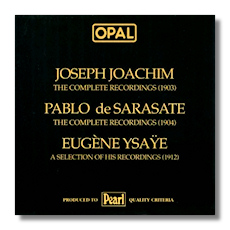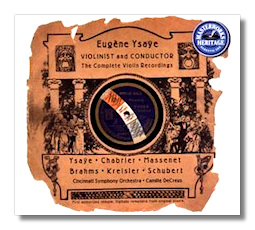
The Internet's Premier Classical Music Source
Related Links
-
Find CDs & Downloads
Amazon - UK - Germany - Canada - France - Japan
ArkivMusic - CD Universe
Find DVDs & Blu-ray
Amazon - UK - Germany - Canada - France - Japan
ArkivMusic-Video Universe
Find Scores & Sheet Music
Sheet Music Plus -
Search Amazon
Recommended Links
Site News
Reproduction vs. Interpretation
Some Thoughts on Modern Violin Performance

The great Belgian violinist Eugène Ysaÿe (1858-1931) has been seen by many as a "bridge" between the highly individualistic, interpretation-minded nineteenth century, and the increasingly depersonalized and text-conscious (true to composer's "intentions") twentieth century. The fact that Ysaÿe has been called such things as a "bridge," and a synthesis of the conflicting styles of Joachim and Sarasate, reveals the extent and depth of influence of the prevalent mindset of our century. It is sad that the proliferation of modern-day, one-dimensional performers (astoundingly technically proficient though they be) has led so many critics, and even violinists, to view the latter-day greats only in light of their deviations from our established norms, or standards of performance. Even such a commentator as the violinist Henry Roth, whom one would expect to show a greater level of insight, succumbs to the pitfalls of modernity. He writes in his recent book Violin Virtuosos: From Paganini to the Twenty-First Century (California, 1997): "The greats of the latter 19th century were giants of their day, and as such we owe them respect and reverence, but they would indeed cut a sorry figure if placed upon the modern concert stage" (p. 4). But he then, a few pages later, goes on to lament the disappearance of an individual sound and personality among modern violinists (p. 6). Only his cry is not sustained, and one is led to ask the question: What is more difficult to achieve, and therefore more precious and worthy of praise, a note-perfect technical proficiency in performance that sounds computer-generated, or a truly sublime (in Longinus' sense) personal intepretation of a work to which the performer feels a strong attachment? I say the latter, and I will discuss the example of Ysaÿe in such a spirit.
First, let us take the example of the man as composer; for it is the status of the composer, insofar as he is considered in our time to have autonomous control over the interpretation of his work, that I will here be bringing into question. When Ysaÿe composed his most famous work, the Six Sonatas for Solo Violin, Op. 27, the year was 1924 – the same year that Andre Breton wrote the Surrealist Manifesto. The spirit of individual freedom in expression and interpretation was beginning to pervade literature, which till then had been subject to strict bourgeois regulations of content and presentation. The ultimate simultaneous affirmation and denial of the self was being carried out in the experiments with "automatic writing," just as the riotous atmosphere created by the Dada movement was beginning to peter out. It was no accident that Ysaÿe should choose at that time to practice what he had always preached – or should I say performed? – by dedicating each of his sonatas to a young contemporary violinist, after writing the said sonata virtually to order, by taking into consideration the particular favored style of each. Is it coincidental then, I wonder, that the only sonata of the six that is "classic in form" is the number four, dedicated to Kreisler: the only one out of the five dedicatees whose name is still a (classical- music- educated) household word? Kreisler's style is the one that is, out of the other dedicatees who happened to make recordings, and by any account, the least jolting to the modern ear. Why? Possibly because he was the least individualistic. Even his compositions did not approach the level of profundity and radicality of Ysaÿe's. Not to say they should have! I'll abandon the point. Anyway, my MAIN point is, it is significant that when Ysaÿe took up the composition of a work, he allowed his individuality as performer to fade into the background, and make way for the style of the individual he was composing for. What's more, he did not allow himself to get lost in the midst of such an endeavor; the trace of his own style is always there, always present… it melds with the style of the dedicatee and culminates in a hybrid style, with Ysaÿe as its center – its father, if you will. Ysaÿe was above attempting to deny influences. In fact, the inspiration to compose those solo sonatas came, in the first place, from his hearing a performance of a Bach Partita by Szigeti.
Now, to consider Ysaÿe the performer, I think it is important to note that he was never a "child prodigy"; unlike so many of our modern performers, as well as those of yesteryear, he did not "give his first performance at the age of seven" (which I, personally, think is ridiculous). No. His developmental period was quite ample; and as we know today, the richness and depth of a personality is in a constant state of evolution. It is that all-important freedom and openness of form that allowed Ysaÿe to grow the way he did; that allowed him to retain that flexibility of mind which enabled him to compose his sonatas. The strict imposition of rules in childhood stifles the creative impulse. Roth, in his book, has nothing good to say about Ysaÿe's performance of Kreisler's Caprice Viennois, a performance which I found deeply satisfying. His view is that because Ysaÿe's tempo is slower than what we have heard from Kreisler (the composer of the piece), making the overall effect of the piece, as I see it (or hear it), melancholy instead of elegant, that it is a case of miscasting, or error in selection, on the part of Ysaÿe (p. 27). To me, it was nothing less than a great performer taking a piece and molding it to fit the needs or whims of his personality. As is often said in modern literary theory of an author: when he yields up his work to the reader (in this case the performer) he also yields up any claims of control over, and responsibilty for, the work's reception and meaning (effects of interpretation). Roth has no right to complain about it, neither did Kreisler (if he ever did, which I think unlikely), for the great César Franck commented thus "[w]hen it was once pointed out to him that [Ysaÿe's] performance of the Franck sonata, though wonderful, did not conform to the composer's directions: 'This may be so, but from now on it will be impossible to play it any other way. Don't worry, it is Ysaÿe who is right'" (Roth, p. 31). Now I don't agree with Franck's imposition of a limitation, but I can commend the overall spirit of the statement, in that it allows for the acceptance of an equal responsibility for the music on the part of the performer.
Perhaps our period in time, in history, has alot to do with the aforesaid depersonalization in the realm of musical performance. Especially the post-World War II era, in which an extreme suspicion and perhaps even hatred of nationalism prevails. Ysaÿe was of the Belgian School, and deeply proud of it. Such "schools" contributed, in a context-creating manner, to the diverse playing styles which graced the musical world at that time. In our own time, with the lingering shock of the Holocaust and all, I think many find a sort of reassurance in the lack of individuality, whether in a nationalistic context or not; for when everyone operates like a mindless machine, there is no danger of any individual or megalomaniac whim manifesting itself in the space of collective reality, and wreaking horrifying havoc.
The drive to uncover origins is another twentieth-century fixation; and for those involved with Musick, such a pursuit is particularly problematic. For the origin of recording (the only real documentation of musical performance available to us) is not the origin of the instrumental art, it is the origin of a certain form of technology. This explains the reason for the positing of Ysaÿe as a bridge or synthesis of whatever sort. It is not wise to use Joachim or Sarasate as the representation of the origin of modern violin playing, for their respective recordings were made when they were both past their prime as performers – not to mention the fact that both their styles were just a little too removed from the present ideal to qualify. Ysaÿe, however, who taught many of the leading violin figures of this century, and whose playing is not too outrageously nineteenth century, fit the origin bill perfectly.
I will recommend, for those of you who normally listen to relatively modern recordings, one disc with performances by those primordial masters, Joachim and Sarasate, for, initially, its value as shock therapy for twentieth century-trained ears, and most importantly, for the priceless experience of having true works of art communicated to you by dedicated devotees over the temporal distance of nearly a century.
The disc is: OPAL CD 9851, Joachim and Sarasate: the complete recordings, Ysaÿe: a selection of his 1912 recordings
I recommend this one especially for the precious interpretations by Joachim of Bach's Bouree from the B minor Partita, and the Adagio from the G minor Sonata. Even through the copious surface noise one can still detect a serious, classically powerful tone that does more justice to Bach than even Itzhak Perlman's famous recording. Also astounding is the "devil-may-care" abandon with which the Prelude from Bach's E Major Partita is played by Sarasate; and the performance of his own Zapateado definitely captures the magic of the moment.
The full magic of Ysaÿe's talent as performer, as well as conductor, is glaringly apparent on Sony Classical MHK62337, Eugène Ysaÿe, Violinist and Conductor: the complete violin recordings
This recent disc contains the performance of Kreisler's Caprice Viennois that I discussed above, as well as a host of other inimitable interpretations and performances of original works. A favorite of mine is Chabrier's Piece Pittoresque No. 10 – not to mention the final movement of Mendelssohn' violin concerto, with piano accompaniment. The performances on this disc illustrate perfectly my point concerning the superiority of an individualistic interpretation versus a machine-like performance.
And finally, for a worthy experience of Ysaÿe's solo violin sonatas, I refer you to the recording by Oscar Shumsky, on Nimbus NI7715 (previously issued as NI5039). Shumsky is one of the few modern violinists to whom I can listen with undistracted pleasure. He plays as if it is his hobby, not his career – and that is infinitely commendable. Check it out.
Those with comments, protests, praise or insults may fire back.
Copyright © 1997, Edward Moore
Back to Ysaÿe
















